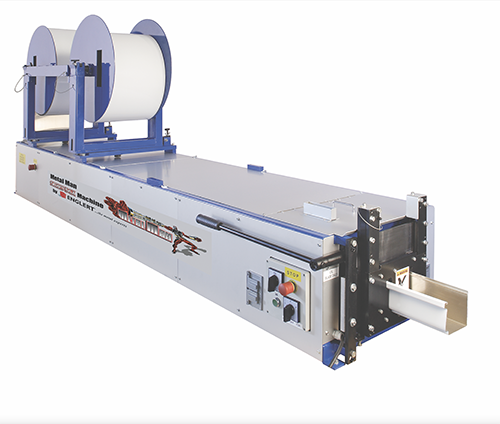Gutter Machines: The Ultimate Solution for Seamless Gutter Installation
Introduction Gutters are essential components of any building, designed to collect and direct rainwater away from the roof and foundation....

Introduction
Gutters are essential components of any building, designed to collect and direct rainwater away from the roof and foundation. They protect the structure from water damage and help maintain the integrity of the building. Traditional gutter installation methods can be time-consuming and prone to errors, leading to seams, leaks, and misalignments. However, with the introduction of gutter machines, the entire process has been revolutionized. These machines make it possible to create seamless gutters quickly and with precision, reducing labor costs, material waste, and installation time.
What Are Gutter Machines?
A gutter machines is a specialized piece of equipment used to produce seamless gutters on-site. Unlike traditional gutters that are pre-fabricated and then installed, gutter machines allow contractors to form gutters from a continuous coil of material, creating custom lengths that fit the specific dimensions of a building. The seamless design eliminates joints and seams that can lead to leaks and structural damage over time.
Gutter machines are designed to roll-form a variety of materials, most commonly aluminum, steel, and copper, into the desired gutter profile. These machines are highly efficient and can be used to produce a variety of gutter shapes and sizes to meet the needs of different roofing projects.
How Do Gutter Machines Work?
The process of creating seamless gutters with a gutter machine involves several key steps:
1. Loading the Coil
The first step is to load the metal coil into the machine. These coils are available in a variety of materials, such as aluminum, steel, and copper, and in different gauges depending on the project requirements. The coil is typically around 5 to 6 inches wide and can be several hundred feet long.
2. Forming the Gutter Profile
Once the coil is loaded into the machine, it feeds through a series of rollers that gradually shape the metal into the desired gutter profile. The machine uses a process called roll forming, where the coil passes through a series of rollers, each bending the metal a little more until it reaches the final shape.
3. Cutting the Gutter
Once the gutter profile is formed, the machine will automatically cut it to the correct length. The length is determined based on the dimensions of the building and the specific gutter installation requirements. The machine cuts the metal with high precision, ensuring that the gutter fits perfectly without the need for seams.
4. Finishing Touches
Once the gutter is formed and cut, the machine can apply additional features such as end caps or brackets, depending on the installation requirements. Some gutter machines are also capable of creating downspouts and other related components.
5. Installation
After the seamless gutter is produced, it is ready to be installed along the building’s roofline. The installation process is quicker than traditional methods because there are no seams to join, reducing the chances of leaks.
Types of Gutter Machines
There are several types of gutter machines available on the market, each designed for different applications and materials. Here are the most common types:
1. Box Gutter Machines
Box gutter machines are used to create box-style gutters, which are rectangular in shape. These gutters are commonly used for commercial or industrial buildings, as they can handle a higher volume of water flow than traditional half-round gutters. Box gutter machines are larger and heavier than other gutter machines, but they provide excellent efficiency for high-demand projects.
2. K-style Gutter Machines
K-style gutters are the most popular gutter profile in North America. They are shaped like the letter “K” and are commonly used in both residential and commercial buildings. K-style gutter machines are versatile and can be adjusted to create different sizes of K-style gutters. These machines are often more compact and easier to transport than box gutter machines.
3. Copper Gutter Machines
Gutter machines that work with copper require specialized rollers and adjustments to accommodate the material’s unique properties. Copper gutter machines are typically used for luxury homes, historic buildings, and structures requiring a more aesthetically appealing finish.
Advantages of Using Gutter Machines
Gutter machines provide numerous benefits over traditional gutter installation methods. Here are the key advantages:
1. Seamless Design
One of the biggest advantages of using gutter machines is the ability to create seamless gutters. Traditional gutters are typically pieced together with multiple sections, which can lead to leaks at the seams. Seamless gutters, on the other hand, are continuous, reducing the likelihood of water leaks and enhancing the overall durability of the roofing system.
2. Customization
Gutter machines allow contractors to create gutters in custom lengths to fit the exact dimensions of the building. This eliminates the need for cutting or joining sections of pre-made gutters, resulting in a cleaner and more accurate installation. Additionally, gutter machines can produce different profiles, such as K-style or box-style gutters, depending on the project’s needs.
3. Time and Cost Efficiency
Using a gutter machine significantly reduces the time and labor required for gutter installation. The process of forming and cutting gutters is automated, allowing contractors to produce large quantities of seamless gutters quickly. This not only saves time but also reduces labor costs, making it an attractive option for contractors looking to improve their profitability.
4. High-Quality Results
Gutter machines ensure a high level of precision during the manufacturing process. Since the gutters are formed on-site and custom-made to fit the building, they provide a more professional and polished appearance. The continuous metal also minimizes the risk of sagging, cracking, or warping, which can occur in gutters with seams or joints.
5. Reduced Waste
Since gutter machines produce custom-sized gutters on-site, there is less material waste compared to pre-fabricated gutters. The ability to create gutters based on the exact measurements of the building ensures that contractors use the optimal amount of material, contributing to more sustainable building practices.
6. Versatility
Gutter machines can handle a wide range of materials, including aluminum, steel, copper, and other metals. This versatility allows contractors to work on various projects, from residential homes to large commercial buildings, without needing different machines for each material type.
Conclusion
Gutter machines have transformed the way gutters are produced and installed, offering numerous advantages over traditional methods. These machines not only provide high-quality seamless gutters but also reduce installation time, lower labor costs, and minimize material waste. Whether you’re working on a small residential project or a large commercial building, investing in a gutter machine can help improve the efficiency and quality of your work.



